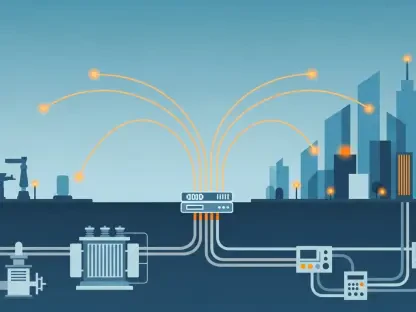In an era where industrial systems are increasingly intertwined with digital networks, the surge in cyber threats targeting operational technology (OT) environments has become a pressing concern for critical industries. A recent comprehensive report on OT security revealed alarming statistics, highlighting that manufacturing alone accounts for over 41.5 percent of all threat detections, with nearly 62 percent of ransomware incidents specifically aimed at disrupting production capabilities. Sectors like transportation, utilities, and energy are also under siege, facing sophisticated attacks from state-sponsored actors and ransomware groups. These threats exploit the fragile boundary between IT and OT systems, leveraging poor network segmentation and human vulnerabilities through social engineering. As digitalization accelerates, the need for robust defenses has never been more urgent, pushing organizations to rethink their security posture and adopt proactive measures to safeguard critical infrastructure from evolving dangers.
1. Escalating Threats in the OT Landscape
The current threat landscape for operational technology reveals a stark reality: adversaries are becoming more strategic and coordinated in their attacks. State-sponsored groups and ransomware operators, such as those known for targeting industrial control systems (ICS), are focusing on exploiting the convergence of IT and OT environments. This convergence often results in insufficient barriers between corporate networks and industrial systems, allowing attackers to pivot from IT to OT through compromised workstations or shared credentials. Manufacturing remains the most targeted sector, bearing the brunt of disruptions aimed at halting production and causing economic damage. Beyond technical exploits, social engineering tactics are increasingly used to manipulate employees into granting access or revealing sensitive information. This dual approach of technical and human exploitation underscores the complexity of defending OT systems, where a single breach can cascade into catastrophic operational failures across critical industries.
Another critical aspect of the escalating OT threat landscape is the growing sophistication of attack methodologies. Adversaries are not merely seeking to infiltrate systems but are aiming to maintain persistence within networks for long-term disruption. The exploitation of remote-access solutions has become a common entry point, as many organizations fail to secure these tools adequately. Additionally, the rise in coordinated campaigns by state-sponsored actors indicates a shift toward geopolitical motivations, where disrupting infrastructure serves broader strategic goals. This trend poses significant challenges for industries like utilities and energy, where downtime can impact national security and public safety. The data clearly shows that without immediate action, the vulnerabilities at the IT/OT boundary will continue to be exploited, leading to more frequent and severe incidents. Addressing these threats requires a fundamental shift in how security is approached, moving beyond reactive measures to a more anticipatory and layered defense strategy.
2. Building Robust Defenses Through Architecture Hardening
To counter the mounting risks at the IT/OT boundary, organizations must prioritize architecture hardening as a foundational element of their security strategy. Implementing robust network segmentation, aligned with standards like ISA/IEC-62443, is essential to create dedicated security zones for OT networks while controlling access points between IT and OT environments. Deploying network detection and response tools can further prevent lateral movement by identifying and mitigating threats in real time. Additionally, endpoint hardening through anti-malware and integrity control software ensures that unauthorized changes or software installations are blocked, reducing the risk of compromise. Leveraging frameworks like the NIST Cybersecurity Framework, tailored for OT-specific controls, provides a structured approach to asset inventory, risk-based vulnerability management, and incident response. These combined measures form a critical barrier against attackers seeking to exploit interconnected systems.
Beyond basic segmentation and endpoint protection, continuous monitoring plays a pivotal role in maintaining a secure OT environment. Implementing systems such as Security Information and Event Management (SIEM) solutions offers visibility into both IT and OT domains, enabling early detection of anomalies that could indicate a breach. This proactive monitoring must be paired with regular updates to security protocols to address emerging vulnerabilities. Hardening efforts should also extend to operational practices, ensuring that engineering workstations and other critical access points are fortified against compromise. By adopting a risk-based approach to vulnerability management, organizations can prioritize the most critical patches and updates, minimizing exposure to known exploits. This comprehensive strategy not only reduces the attack surface but also builds resilience against sophisticated threats, ensuring that industrial operations remain secure even as adversaries evolve their tactics over time.
3. Strengthening OT Supply Chain Security
Securing the OT supply chain is another vital component in defending against cyber threats, as third-party vendors and integrators often represent a weak link in the security chain. Enforcing zero-trust principles for vendor access is crucial, treating all external connections as untrusted by default. This involves implementing granular, time-bound credentials, device control, and session monitoring for remote maintenance activities. Additionally, requiring vendors to provide software bills of materials (SBOMs) ensures transparency into the components of supplied software, allowing for validation of digital signatures and monitoring for outdated or tampered elements in updates. Embedding cybersecurity clauses into supplier contracts further holds vendors accountable, mandating secure update practices and immediate incident reporting. These steps collectively reduce the risk of supply chain attacks that could compromise critical OT systems.
Beyond vendor access controls, organizations must focus on isolating supplier-facing gateways from production networks to prevent unauthorized data exchange or command activity. Continuous monitoring of outbound traffic is necessary to detect potential breaches originating from third-party interactions. Enhancing vulnerability management with Common Vulnerabilities and Exposures (CVE) intelligence and attack path analysis ensures that the most pressing security gaps are addressed promptly. This data-driven approach helps prioritize patches based on their potential impact on operational continuity. Collaboration with industry peers through public-private information sharing and security alliances also strengthens supply chain defenses by providing insights into emerging threats and best practices. By adopting these measures, organizations can build a more resilient supply chain, mitigating risks that stem from external dependencies and ensuring the integrity of their OT environments.
4. Empowering Teams and Fostering Collaboration
Human error remains a significant vulnerability in OT security, making enhanced training and readiness programs essential for risk reduction. Regular training sessions focused on emerging threats, phishing attempts, and safe handling of sensitive information can equip employees to recognize and respond to potential dangers effectively. These programs should simulate real-world scenarios to build practical skills, ensuring that staff are prepared to act decisively during an incident. Tailoring training to specific roles within the organization, such as operators and engineers, ensures relevance and maximizes impact. By fostering a culture of security awareness, organizations can transform their workforce into a first line of defense against social engineering and other manipulative tactics employed by threat actors, significantly lowering the likelihood of successful attacks.
Collaboration extends beyond internal teams to include industry-wide efforts that bolster OT security. Participating in public-private partnerships, industry forums, and security alliances facilitates the exchange of critical intelligence on evolving threats and defensive strategies. Such platforms enable organizations to stay ahead of adversaries by learning from shared experiences and adopting proven practices. This collective approach is particularly valuable in addressing systemic vulnerabilities that affect entire sectors, such as energy or transportation. Additionally, engaging with regulatory bodies to align security practices with compliance requirements ensures a standardized level of protection across industries. These collaborative efforts, combined with internal training initiatives, create a comprehensive framework for OT security that addresses both human and systemic risks, paving the way for sustained operational resilience.
5. Reflecting on Past Actions for Future Resilience
Looking back, many organizations faced significant challenges as OT threats escalated, often struggling with inadequate network segmentation and insufficient training that left systems vulnerable. Past incidents demonstrated how attackers exploited IT/OT convergence, using compromised credentials and remote-access tools to disrupt critical operations. The heavy targeting of manufacturing, which bore the majority of ransomware attacks, highlighted the urgent need for tailored defenses in high-risk sectors. Reflecting on these events, it became evident that reactive measures fell short against coordinated campaigns by state-sponsored actors and ransomware groups. The lessons learned underscored the importance of proactive architecture hardening and supply chain security, which proved instrumental in mitigating breaches. Moving forward, adopting continuous monitoring, zero-trust principles, and industry collaboration will be essential next steps to fortify defenses, ensuring that critical infrastructure remains protected against future threats.









